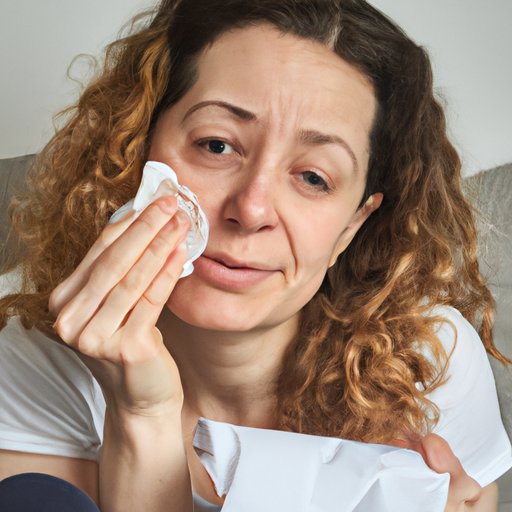I. Introduction
Nosebleeds can be a common and uncomfortable experience for many people. They usually occur when the inner lining of the nose is damaged, causing blood vessels to rupture and bleed. In this article, we will discuss the various causes of nosebleeds and provide practical tips on how to stop them from happening.
II. Common causes of nosebleeds and how to avoid them
Nosebleeds can be caused by a number of factors including dry air, allergies, nasal irritation, nose picking, and medication. To avoid nosebleeds, it’s essential to keep your nasal passages moist by using a humidifier and avoiding irritants, such as smoking, dust, and perfumes. Additionally, drinking enough water can help to prevent nosebleeds.
III. First aid steps for stopping a nosebleed
The first step to stop a nosebleed is to sit down and lean slightly forward. Pinch your nostrils together with your thumb and index finger and hold it for 5-10 minutes. If the bleeding doesn’t stop, repeat the process again. Ice can also be used to constrict blood vessels and reduce bleeding. Avoid lying down or tilting your head back during nosebleeds as this can cause blood to flow down your throat and may lead to choking.
IV. Home remedies for treating nosebleeds
In addition to the first aid steps, various home remedies can help treat nosebleeds. Saline nasal sprays can help to keep the nasal passages moist, while essential oils like lavender or lemon can help to reduce inflammation. A cold compress applied to the forehead or the back of the neck can also be effective in stopping nosebleeds.

V. Complications of nosebleeds that require medical attention
Severe or frequent nosebleeds may require medical attention. If the bleeding persists for more than 20 minutes, or if you start to feel weak or dizzy, seek medical help immediately. Frequent nosebleeds may also be a sign of an underlying condition like high blood pressure, blood clotting disorders, or a nasal tumor.
VI. Medical treatments for nosebleeds
If home remedies and first aid steps fail to stop nosebleeds, a doctor may recommend medical intervention. Nasal packing involves placing a sterile gauze inside the bleeding nostril to stop bleeding. Cauterization involves using heat or chemicals to seal off the blood vessel. As a last resort, surgery may be required to treat chronic or severe nosebleeds. It’s essential to discuss the pros and cons of each method with your doctor and understand their suitability for your condition.
VII. Preventive measures to reduce the likelihood of nosebleeds
To reduce the likelihood of nosebleeds, it’s crucial to identify and avoid the triggers that cause it, such as dry air, allergies, and irritants. Rinsing your nasal passages with saline solution can help keep them moist, while staying hydrated can keep your nasal tissues healthy.
VIII. Managing anxiety or fear about nosebleeds
Some people may experience anxiety or fear due to nosebleeds. Living in fear of having nosebleeds can create a vicious cycle. Deep breathing and distraction techniques can help manage such anxiety. It’s important to remember that nosebleeds are common, and while they may be uncomfortable, they are usually not serious.
IX. Conclusion
Nosebleeds can be dealt with effectively at home by taking precautionary measures and utilizing simple remedies like first aid steps and inhalation therapy. However, it’s vital to recognize when medical intervention is necessary. If you experience severe or frequent nosebleeds, seek medical help immediately. By following the tips outlined in this article, you can reduce the likelihood of nosebleeds and be prepared to manage them if they occur.
